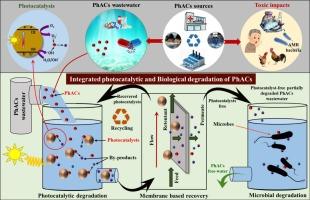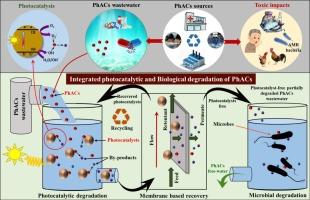Photocatalytic and biological degradation processes to mineralize pharmaceutically active compounds and catalyst recovery: A review
IF 20.3
1区 化学
Q1 CHEMISTRY, INORGANIC & NUCLEAR
引用次数: 0
Abstract
Over the past few decades, the escalating issue of water pollution has primarily originated from the direct discharge of industrial and municipal waste. The perilous ramifications of waste laden with pharmaceutically active compounds (PhACs) are particularly concerning, largely due to the rise of antibiotic-resistant microbes. This makes the implementation of effective treatment processes for mitigating PhAC pollution increasingly difficult. This review highlights the proliferation of PhACs, their risk to aquatic life, and the subsequent development of antimicrobial-resistant microbes. Photocatalysis has emerged as a promising, environmentally friendly approach for pollutant degradation, but its practical application remains limited due to challenges such as poor photocatalytic efficiency, incomplete mineralization, generation of intermediate products, and inefficient catalyst recovery. This review explores bio-based modifications of photocatalytic materials to enhance catalytic performance by lowering the bandgap, delaying electron-hole pairs recombination, and improving hydrophilicity. This review also introduces a novel integrated mechanism combining photocatalytic degradation, membrane-assisted photocatalyst recovery, and biological degradation of PhACs and their intermediates, offering valuable insights for researchers and industrialists.


光催化和生物降解过程使药物活性化合物矿化以及催化剂回收:综述
过去几十年来,水污染问题不断升级,主要源于工业和城市废物的直接排放。含有药物活性化合物(PhAC)的废物所带来的危险后果尤其令人担忧,这主要是由于抗生素耐药微生物的增加。这使得实施有效的处理工艺来减轻 PhAC 污染变得越来越困难。本综述重点介绍了 PhACs 的扩散、其对水生生物的风险以及抗菌微生物的后续发展。光催化已成为降解污染物的一种前景广阔的环保方法,但由于光催化效率低、矿化不完全、产生中间产物以及催化剂回收效率低等挑战,其实际应用仍然有限。本综述探讨了基于生物的光催化材料改性,通过降低带隙、延迟电子-空穴对重组和改善亲水性来提高催化性能。本综述还介绍了一种结合光催化降解、膜辅助光催化剂回收和生物降解 PhACs 及其中间产物的新型综合机制,为研究人员和工业家提供了宝贵的见解。
本文章由计算机程序翻译,如有差异,请以英文原文为准。
求助全文
约1分钟内获得全文
求助全文
来源期刊

Coordination Chemistry Reviews
化学-无机化学与核化学
CiteScore
34.30
自引率
5.30%
发文量
457
审稿时长
54 days
期刊介绍:
Coordination Chemistry Reviews offers rapid publication of review articles on current and significant topics in coordination chemistry, encompassing organometallic, supramolecular, theoretical, and bioinorganic chemistry. It also covers catalysis, materials chemistry, and metal-organic frameworks from a coordination chemistry perspective. Reviews summarize recent developments or discuss specific techniques, welcoming contributions from both established and emerging researchers.
The journal releases special issues on timely subjects, including those featuring contributions from specific regions or conferences. Occasional full-length book articles are also featured. Additionally, special volumes cover annual reviews of main group chemistry, transition metal group chemistry, and organometallic chemistry. These comprehensive reviews are vital resources for those engaged in coordination chemistry, further establishing Coordination Chemistry Reviews as a hub for insightful surveys in inorganic and physical inorganic chemistry.
 求助内容:
求助内容: 应助结果提醒方式:
应助结果提醒方式:


